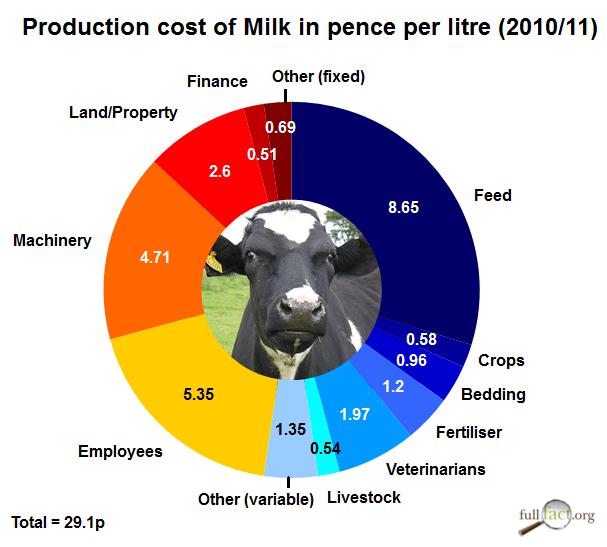Are farmers losing out on a pint of milk?
"The latest cuts will see farmers being paid around 25p a litre for milk, compared to more than 30p it costs to produce."
The Independent, 11 July 2012
"These latest cuts are the feed bills, the wages, the housekeeping and will take us well into loss-making territory, with many farmers losing up to 6p per litre."
National Farmers Union spokesman, 11 July 2012
Join 72,953 people who trust us to check the facts
Sign up to get weekly updates on politics, immigration, health and more.
Subscribe to weekly email newsletters from Full Fact for updates on politics, immigration, health and more. Our fact checks are free to read but not to produce, so you will also get occasional emails about fundraising and other ways you can help. You can unsubscribe at any time. For more information about how we use your data see our Privacy Policy.
Thousands of farmers gathered in London this week to protest at cuts to milk prices, after four leading dairy processors announced price reductions of up to two pence per litre.
Robert Wiseman Dairies, First Milk, Arla Foods UK and Dairy Crest all recently announced cuts of between 1.6 and two pence per litre of milk produced by farmers - due to take effect later this year.
The move certainly provoked outrage, with some farmers' representatives taking to the BBC Today Programme last week to voice their concerns over ever more hard-pressed farmers.
But what do all the figures they've been using actually mean?
Analysis
The main objection raised by the National Farmers Union (NFU) is that dairy farmers are paying more to produce their milk than they are getting from selling it on to processors (companies that pasteurise and bottle milk before selling it on to supermarkets).
This doesn't apply to every farmer in the UK; the NFU claim that the recent cuts will affect around a quarter of all dairy farmers. Many, for instance, will have direct relationships with supermarkets themselves.
In order to check how the cuts might affect the farmers involved, we need to know what it costs the average dairy farmer to produce a litre of milk, and what price processors normally pay for it. Fortunately, both sets of figures are available.
The cost of production
The NFU produced a report in 2009 estimating the cost of milk production - figures which have been cited by the Environment, Food and Rural Affairs Committee.
Using a sample of over 800 dairy farms they estimate that, combining fixed and variable costs, farmers paid 29.1 pence for every litre they produced in 2010/11 - up from 27.35 pence in 2009/10:

The price farmers get
The best available measure for us to work out the average price farmers recieve for what they produce are Farmgate Milk Prices measured in surveys by the Department for Environment, Food and Rural Affairs (DEFRA). They tell us the average price received by farmers for their milk, taking into account delivery charges, although DEFRA admit they are highly variable.
The latest data, for May 2012, shows that milk prices currently stand at 26.99 pence per litre. However, to keep the time periods comparable, for 2010/11 the average milk price was 25.1 pence per litre.
This means that, on average, farmers facing standard farmgate prices from processors will have lost four pence per litre they produced (producing at 29 pence and selling at 25 pence).
The statistic from the Independent reflects this, and the NFU posit that a further two pence cut will send prices even lower, increasing the loss to around six pence per litre.
What do the processers and retailers get out of it?
Market information and trade company DairyCo compile several relevant indicators of liquid milk margins. They simply compare the farmgate milk price with processor and retail prices of milk (per litre) to estimate where the margins lie.
Their latest statistics report employs retail, processor and farmgate data to make these comparisons. For 2010/11, they again use the 25.1 pence per litre farmgate price of milk (received by farmers).
For the same year, the processor selling price was 38.7 pence per litre - which represents the price paid by retailers to acquire the treated milk. The retail price in the same year was 58 pence per litre (normally sold as a four-pint 'polybottle' for around £1.25) - which is obviously what consumers pay for their milk on the shelves.
Conclusion
The available figures from DEFRA, the NFU and DairyCo lend weight to the figures used by the Independent earlier this week. It should be remembered that they don't apply to all farmers, as some get more favourable deals directly with retailers.
However all of the figures are uncertain to an extent. DEFRA itself admits that there is a wide variation in farmgate prices, for instance, and the production cost of milk will vary greatly depending on the price of feed and the weather, which can influence the maintenance costs that are factored in.
Nevertheless, the gap between farmers' production cost and selling price shows that the average farmer under these circumstances makes a loss on every litre of milk they produce. The concerns raised by the NFU this week seem well founded.